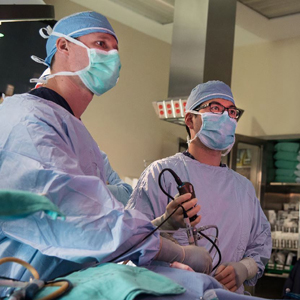Otorhinolaryngology and Neurosurgery Team Up to Maximize the Outcome for a Patient with Pituitary Tumor
 After an unexplained “brain glitch” led to the discovery of a large pituitary tumor, retired corrosion engineer Niell Strickland joined the ranks of patients who have benefited from the teamwork of rhinologist William Yao, MD , and neurosurgeon Spiros Blackburn, MD. The two specialists work together at Memorial Hermann-Texas Medical Center to ensure a smoother road to recovery and improve outcomes for patients with pituitary and skull base tumors and disorders.
After an unexplained “brain glitch” led to the discovery of a large pituitary tumor, retired corrosion engineer Niell Strickland joined the ranks of patients who have benefited from the teamwork of rhinologist William Yao, MD , and neurosurgeon Spiros Blackburn, MD. The two specialists work together at Memorial Hermann-Texas Medical Center to ensure a smoother road to recovery and improve outcomes for patients with pituitary and skull base tumors and disorders.
斯特里克兰(Strickland)在2015年12月和家人在教堂午餐后庆祝妻子的生日时,首先注意到了一个问题。他回忆说:“我们下达了订单,坐在桌子旁来访,我突然遇到了表达的困难。”“我可以清楚地思考,但无法使这些话浮出水面。事件在一两分钟的时间内通过,没有任何人注意到,我恢复了正常。”他提醒他的妻子,几天后,他们看见了他的初级保健医生,后者立即将其转交给了医学博士Hazan Machkhas。“博士马克哈斯(Machkhas)在同一天给我发送了MRI,并在那天傍晚给我打电话。”他说。“尽管他们没有发现任何可能在周日为该活动做出直接贡献的东西,但他们确实发现了一个非常大的垂体肿瘤。”
斯特里克兰(Strickland)是由德克萨斯医学中心纪念馆赫曼·米歇尔(Hermann Mischer)神经科学研究所和医学博士Spiros Blackburn的纪念馆主任神经外科医师(Dong Kim)看到的,他专门从事脑血管和颅骨底部的底部疗法,并且在内窥镜和血管内神经穿刺手术方面具有专业知识。75岁的斯特里克兰说:“我了解到肿瘤位于垂体上,向上和向外推动右视神经。布莱克本博士要求我的眼科医生测试外周视觉的丧失 - 没有肿瘤的大小令人惊讶。他还将我转介给Yao博士。”
William Yao博士在Uthealth的McGovern医学院担任Otorhinolaryngology-Head和Neck Surgery系的助理教授,在马萨诸塞州眼睛和耳部医务室/哈佛医学院完成了Rhinology和前颅骨基础手术研究金后,加入了教师。他撰写了许多在同行评审期刊上发表的文章,以及有关脑和脑颈外科手术(第二版)和ENT Secrets(第3版)的脑膜和颅底手术的手术管理的章节。Yao博士说:“除了垂体肿瘤外,斯特里克兰先生还经常出现鼻窦问题和偏离的隔膜。”“得益于我们与神经外科的合作,我们可以通过一个微创手术来照顾一切。我进行鼻窦手术并提供对大脑的接触,获得了大量暴露,该暴露使布莱克本博士能够完全清除肿瘤,同时最大程度地减少对垂体的损伤。与使用显微镜的传统手术相比,我们对角度内窥镜的使用可以更大的放大倍率和优越的视野 - 以及更安全,更完整的切除。”
In the years they’ve worked together, the two surgeons have collaborated on dozens of procedures. “We’re in sync,” Dr. Yao says. “We augment each other’s surgical skills and expertise. I create a favorable approach that allows Dr. Blackburn the access he needs to remove the tumor in its entirety. Because of the frequency with which we operate together, we know each other’s moves. It’s harmony between two specialties, like a symphony with multiple instruments. While our knowledge sets overlap, they’re completely different. By working with him, I learn about neuroanatomy from the neurosurgery perspective. Our partnership is such that if there is something that concerns either of us, we can drop in and help each other out at any time.”
布莱克本博士在埃默里大学(Emory University)完成了脑血管奖学金,并在华盛顿大学的Mallinkrodt放射学研究所(Mallinkrodt Institute of Washington University)同意。他说:“有些神经外科医生本身会做这些病例,但我们更倾向于团队的方法。”“我们的手术技能集重叠。Yao博士可以采取更好的方法,并具有内窥镜的专业知识。在手术的第一部分,我协助。我们一起到达塞拉,然后我接任主要外科医生,他在肿瘤切除期间有助于他。然后,我在他关闭时再次提供帮助。我的奖学金培训使我非常熟悉跨界和前颅底碱基的方法,这很重要,但是与Yao博士合作在复杂的情况下非常有价值。我可以问Yao博士,如果我们使用特定的鼻内方法来更好地接触暴露,这将如何影响患者的康复?”
布莱克本博士去除斯特里克兰的肿瘤后,雅博士使用硬脑膜再生矩阵作为移植物重建了大脑和鼻子之间的障碍。Yao博士说:“我从右侧从鼻腔里收集一块组织。”“一旦一切愈合,覆盖移植物就会融合在一起,并形成新的粘膜衬里,以重新建立鼻子和大脑之间的障碍。”
Working together, the two surgeons were able to completely remove the pituitary tumor, which measured 2.5 centimeters in diameter. “It was an incredibly delicate surgery,” says Strickland, who has an engineer’s interest in the surgical process. “The tumor came out nicely and without complication. I spent 24 hours in the Neuroscience ICU and then a couple of days while we waited for the hormone test results to come back. When they came back with good numbers, I was discharged.”
姚博士有一个赞赏的病人an interest in their surgeries. “We go into the OR together,” he says. “The patient is an important member of the team, so it’s great when we’re on the same page. Because no two patients are alike, we tailor the approach and exposure to the individual based on the size of the tumor and its location. When we use the endoscopic approach, recovery is faster and better tolerated by the patient. The three-day hospital stay gives us time to make sure the patient hasn’t developed a hormone deficiency after surgery and to ensure that there are no brain fluid leaks. From a strictly surgical recovery standpoint, most patients could be discharged home the same day. In Mr. Strickland’s case, his recovery time was decreased and his nasal congestion was resolved as an added benefit of using the endoscopic approach to access the pituitary.”
A follow-up MRI confirmed that Strickland’s right optic nerve was back in place, with no involvement of the left optic nerve. He scheduled an exam with his ophthalmologist to confirm that there was no deterioration of his peripheral vision following the procedure.
斯特里克兰(Strickland)认为,他在妻子的生日庆祝活动中经历的大脑故障导致肿瘤发现视力丧失。他说:“手术后一周,我出去走进附近,两三个星期后,我回到了跑步机上。”“在我出院一个月后,布莱克本博士给了我批准,以返回我在健身房的常规锻炼程序。我永远感谢两位医生的技能以及他们花费的时间。他们俩都很棒。现在,我认为他们是我最好的朋友。”